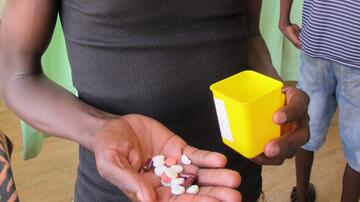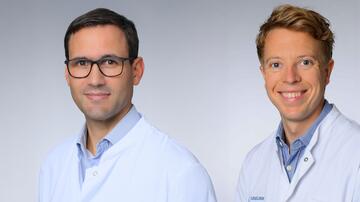The clock is ticking! Three people dying of tuberculosis every minute
World TB Day 2021: A talk with Christoph Lange from the Research Center Borstel
The clock is ticking: The motto of this year's World Tuberculosis Day makes clear that tuberculosis still remains one of the world's deadliest infections. In particular, people in poorer countries are affected who do not have access to medicines. We discussed the treatment of this disease and the latest research results at the German Center for Infection Research (DZIF) with the tuberculosis expert Christoph Lange from the Research Center Borstel.
Mr Lange, how many World Tuberculosis Days will there need to be held before this disease finally disappears from the world?
Christoph Lange: I believe that we will not live to see the world tuberculosis-free. In 2014, the WHO had set very ambitious targets: by 2035 to have achieved a significant reduction in the incidence of tuberculosis, i.e. of new cases. We are far from that. On the contrary, the incidence rate is slow to fall, and we have never had as many people in the world infected with TB as we do now.
What are the most urgent problems for research to solve now?
Christoph Lange: Eliminating tuberculosis will only be possible if we have a vaccine that prevents the disease and is better than the current BCG vaccination. This had originally been developed 100 years ago on cows against bovine tuberculosis and is not sufficiently effective. From 1998, it has no longer been recommended in Germany. But there are now more than 20 candidates for vaccines being tested in clinical trials. Most advanced in its development in Germany is probably the vaccine by Prof. Stefan Kaufmann of the Max Planck Institute for Infection Biology in Berlin, based on the original BCG vaccine. We have to wait for the results of the clinical tests. Furthermore, an important study was published last year on another vaccine, examined in South Africa. Three years after vaccination, only about half as many tuberculosis cases were found in the vaccine population compared to a control population. If this continues to be the case, exhaustive vaccination could prevent half of the tuberculosis cases in the world, resulting in only five million cases per annum instead of 10 million cases now. That would be a very substantial contribution to reducing tuberculosis in the world.
Until then, the focus is on the treatment of those affected. More and more patients have multi-resistant pathogens, which means that they no longer react to standard drugs. How are those affected currently treated?
Christoph Lange: The WHO currently recommends five drugs, of which patients must take at least four. Traditionally for more than 18 months, under certain conditions and with the use of the latest medicines, nine to twelve months are possible. The treatment is often associated with side effects. And another problem: the drugs are often not available. We are currently conducting a study in Europe, where we are looking at what is actually available for the treatment of multi-resistant and extensively resistant tuberculosis, for which all drugs fail. And it turns out: in half of the countries, adequate therapies are not available.
So, you treat multidrug-resistant cases with four drugs for about 18 months. Is that really necessary?
Christoph Lange: The recommendation to treat patients with multi-resistant tuberculosis over 18 months, which is still the standard, is very broad-brush. Of course, not all patients need this long to heal. But up to now, we did not know, and we still do not know for certain, how long for we actually have to treat. It is an infectious bacterial disease in which one would ideally check for bacteria in the sputum [coughed-up phlegm] every month. We know for certain that we must not stop as soon as we no longer find bacteria in the sputum. Many patients subsequently suffer a relapse because many bacteria still remain in some form of retreat where they can survive for an extended period. Most patients no longer have bacteria in the sputum after three months, and yet we treat for 18 months in the interest of safety. This has long been a source of frustration to us. What is needed is a biomarker that can tell us when the individual patient is cured.
You have recently found such a biomarker that could significantly shorten the duration of this severe treatment. What does this biomarker look like?
Christoph Lange: We have actually found such a biomarker in the blood. This is teamwork, with many contributors to this success. I would like to pick out by name the achievement of my young colleagues Maja Reimann and Jan Heyckendorf. With great support from the DZIF, we have already begun in 2015 with the establishment of cohorts. On the one hand, of patients with sensitive and thus easily treatable tuberculosis. On the other, of female patients with multidrug-resistant tuberculosis, of whom we know that they will not be healthy again after six months. We have regularly determined the RNA [ribonucleic acid] in the blood samples. The blood contains approx. 50.000 different mRNAs of genes. These are messenger substances that are converted into proteins and yield individual patterns. We then looked at whether certain genes in the patients were regulated up or down in a certain way, thus perhaps making a statement about the disease. In the end, we were able to find 22 mRNAs of significance for tuberculosis in these patients. This signature from 22 genes will probably allow us to recognise a safe end to treatment and a cure. This is indeed a milestone. The next step is to test this biomarker once again with comparison groups. We hope that a treatment stop by the biomarkers in the one group will not lead to more relapses than in a comparison group without such a biomarker stop, in which the treatment generally continues for longer.
Is such a genetically modified biomarker also suitable for use in poorer countries?
Christoph Lange: That is our aim. We are working with a company to develop a diagnostic platform of the size of a coffee maker that can then be used anywhere and that tells the doctors: this patient still needs a little longer or that patient has been cured. If this works, patients would need 130 days less on average. That is a great deal, considering that many patients suffer from side effects, and that the treatment is often an ordeal for them. In Germany, tuberculosis treatment costs around EUR 100 a day, so it would also save a lot of money. A milestone for precision medicine.
Precision medicine is a key to efficient tuberculosis therapy. In addition to biomarkers, how important are new drugs?
Christoph Lange: There is a great need for new medicines. Many of the drugs in use now are old. At the end of 2013, two new tuberculosis drugs were added after a long pause for development. But against one of these, bacteria are becoming increasingly resistant, so we are losing our best weapon in the fight against tuberculosis. Developed by the Hans-Knöll Institute in Jena together with the team led by Professor Michael Hölscher in Munich, we have a new substance at the DZIF called BTZ 043, which is already being evaluated in the second clinical phase. The DZIF is also one of the sponsors of the largest study to evaluate new drugs against tuberculosis in Europe. UNITE4TB is the name of our new consortium in which ten new drugs will be tested in the coming years.
Mr Lange, the clock is ticking. Three people die of tuberculosis every minute. Do you see a chance for tuberculosis to become a curable disease in the foreseeable future for everyone, including the poorest?
Christoph Lange: We have become somewhat accustomed to the fact that until 2020 tuberculosis has been the most common infectious disease leading to death. It was not until the end of 2020 that COVID-19 suddenly appeared, causing slightly more deaths than tuberculosis. However, the deaths of almost 1.5 million people of tuberculosis in 2020 have received hardly any media response. The disease remains somewhat in the background. More than a third of all tuberculosis sufferers live in India and China, where tuberculosis is commonplace and many resistant cases are untreatable. In order to reduce death rates, early detection is absolutely imperative, although particularly difficult in times of COVID-19. People are tested for COVID-19 and tuberculosis remains invisible. In Europe, we have the opportunity of detecting tuberculosis in good time. Here we have another problem: tuberculosis is so rare that doctors often fail to recognise it. In Germany, we are fortunate that even serious cases can generally be cured. But to reduce tuberculosis mortality worldwide, we need early discovery, new drugs and, indeed, also a vaccine to prevent tuberculosis from occurring.
Dear Mr Lange, thank you for the interview.




